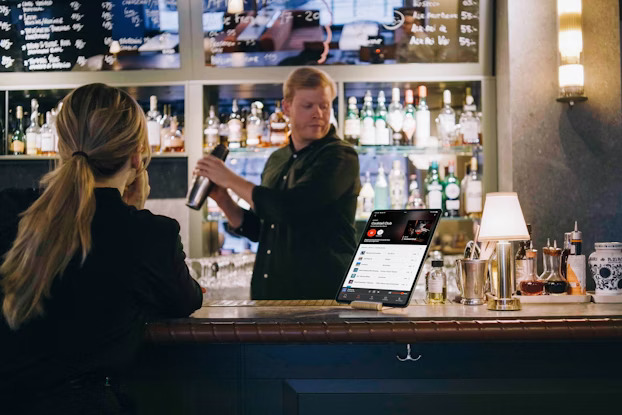Hosting pop-ups at charity events and handing out tri-fold brochures are two of the marketing successes that hand-blown glass company Glassybaby has had. — Glassybaby
Why is this important:
There is an effort underway to phase out third-party cookies that track user preferences, which have historically been a key customer acquisition tool. For candle company Glassybaby, donations have been a powerful strategy that has helped attract new and loyal customers to the brand. Soundtrack Your Brand prioritizes putting prospects in the driver’s seat so they can thoroughly test products before purchasing.
Successful companies know that to grow their brand and revenue, customer acquisition must be an integral part of their core business strategy. But for many, there’s a big hurdle: customer acquisition has become incredibly difficult these days.
Businesses face stiff competition in selling goods and services, but in today’s digital age, low attention spans make it more difficult to attract customers.
At the same time, a customer acquisition tool that businesses have long relied on: the third-party cookie, is falling into disuse. Marketers rely on third-party cookies that track user preferences to segment audiences, create and serve personalized ads, and attract customers. But amid growing privacy regulations to protect consumers’ personal data, third-party cookies are being phased out. In 2020, Google announced plans to gradually phase out third-party cookies in Chrome, beginning the process in early 2024.
As the obstacles mount, businesses today must get creative and navigate a new world of customer acquisition. For Glassybaby, a Seattle, Washington-based manufacturer of hand-blown glass candle holders and drinking glasses with stories to tell, this means partnering with nonprofits, mining data, and relying on tried-and-true marketing techniques like mailers. Their strategy has been so successful that the company is on track to hit $32 million in sales this year, with a goal of $35 million in growth.
“We use a variety of different methods to attract people to the Glassbaby brand,” Danny Baldino, director of new business growth, told CO-, “but donations are our most unique acquisition strategy.”
Giving back to society has been a cornerstone of Glassybaby’s brand since its inception and is now helping the company attract new customers.
When Lee Rose started Glassybaby 20 years ago in her garage, she was battling stage 4 cancer and raising three young children. She wanted to donate a portion of her profits to help families going through cancer treatment pay for their medical expenses.
“We don’t have business goals, we have giving goals,” Baldino said, adding that the company sets its giving goal at the beginning of the year and all business decisions are made toward reaching that goal.
Since then, donations have become a good way to attract new customers. Glassybaby gives about $1 million a year, or 37% of its profits, to charity. To date, it has donated $14 million, and this year, for the first time, it plans to donate $500,000 to the B+ Foundation, a nonprofit that helps children with cancer. The rest goes to various organizations that help people, animals, and the planet.
Pop-up shops at charity events give glassybaby the opportunity to expose their products to new potential customers. For example, Rose recently spoke in Phoenix at the annual brunch for Mother’s Grace, a nonprofit that supports struggling mothers and families. glassybaby made a donation to the nonprofit and then hosted a pop-up shop at the event.
“We use donations to attract new people to the brand,” Baldino said. Pop-up stores are successful because they give people a chance to see, touch and light up the products up close, he said. “It’s a full experience.”
Glassbaby then opened a second pop-up store at a mall in Scottsdale, after which Scottsdale rose to third place in a heatmap showing areas with the highest sales, behind Washington and California.
While Glass Baby has used digital media to acquire customers, it has also had success with more traditional marketing methods such as physical mailings: The company sent tri-fold brochures to roughly 200,000 people in its database who had not received a Glass Baby email, had not shopped with the brand in six months, or had never shopped with the brand before.
Data showed that the highest response rate came from customers who hadn’t shopped with them in six months. This strategy had a return on advertising costs of $5 for every dollar spent on marketing. Glassybaby also ran an email campaign following the mailing campaign.
“People are saturated with digital,” Baldino said. “If you have a beautiful physical mailing, it’s incredibly effective. [mailers] The most successful one.”
Finally, Grassy Baby’s fan base and word of mouth are also powerful customer acquisition tools, Baldino said. Customers have developed rituals around the candles. Some received candles when they lost loved ones and light them regularly in memory of them. Others, like Seattle Seahawks fans, light a Grassy Baby before every game. Limited edition Grassy Babies often sell out within days and have been sent as far away as South Korea.
“Targeting groups with different passions is a key way we acquire new customers,” Baldino said. “When it comes to customer acquisition, a little bit of new and a little bit of old combined creates a little bit of magic.”
[Read: Scaling Startups Share Their Winning Customer Retention Strategies]Targeting different passion groups is a key way we acquire new customers, and when it comes to customer acquisition, a little bit of the old mixed with the new can create a bit of magic.
Danny Baldino, Director of New Business Growth at Glassybaby
For Charitybuzz, customer acquisition happens when a company delivers on a promise of quality and focuses on sharing their story.
Online auction site Charitybuzz has seen the cost of competing in online advertising rise over the years. In response, the company developed a more comprehensive customer acquisition plan: focusing on delivering a high-quality experience to win new customers while also more aggressively pursuing earned media.
“Traditional acquisition channels are expensive,” says Ben Erwin, CEO of Charitybuzz. “Everything is paid for, and it takes a much more competitive environment to break through all the content and get attention for your brand, product or service. So it’s a combination of strategies that actually drives the type of behavior we want.”
This business has the added challenge of needing to acquire a very specific type of customer: one who can afford high-value discretionary items that sell for an average of several thousand dollars at auction, such as dinner with Cher, a book pitch to editor-in-chief Alfred A. Knopf, or a consultation with a celebrity matchmaker. High-value customers are hard to find and expensive to acquire.
“We need to make sure we’re getting people who are interested in what we’re selling and can afford to buy what we’re selling,” he said. “We’re not interested in just acquiring customers per se. We’d rather get 10 genuine leads than 1,000 who just show up and sign up but don’t actually engage.”

Through Charitybuzz, guests were able to catch Olivia Rodrigo’s performance at the Grammy Museum in support of the Grammy Museum Foundation. — Charitybuzz
Charitybuzz’s ability to capture high-quality, unique experiences that deliver on its promise to customers is the true driver of user acquisition, says Irwin. Leveraging this strategy over the past four years, Charitybuzz has acquired over 60,000 additional users, with over 30,000 of those users placing bids.
Quality storytelling is also driving customer acquisition. The company is focused on working with spokespeople for the charities that receive funds after the auction to tell the story of the auction experience through media placements. In the second half of 2024, customer acquisition efforts will include more initiatives, such as thought leadership and conference speaking engagements.
“We want to get out there a little bit more and tell our story,” Irwin said.
[Read: How Advances in Digital Payments Help Brands Enhance the Customer Experience and Reduce the Dreaded Wait in Line]
Business music streaming service Soundtrack Your Brand allows users to try out the platform before committing to anything. — Soundtrack Your Brand
Soundtrack Your Brand invites potential customers for a test drive
Businesses turn to Soundtrack Your Brand when they want to enhance and streamline the background music they play in-store and make it a consistent part of their brand.
According to research from Soundtrack Your Brand, around 87% of all businesses play music, and 20% use music specifically to enhance the customer experience. Businesses that use personal streaming accounts such as Spotify in-store risk being fined for violating copyright laws.
Soundtrack Your Brand, which calls itself the first streaming service for businesses, develops customized streaming lists based on a company’s characteristics, location, and target audience. In April this year, the company introduced an artificial intelligence-powered music playlist generator that creates personalized playlists.
“We’re removing the friction and anxiety around finding the best music for your business and legitimizing it so businesses don’t have to spend hours a week on it,” said founder and CEO Ola Saasz.
Companies won’t face issues with licensing structures or intellectual property usage when playing songs to customers, and can play the right music at the right time for their brand, he added.
Soundtrack Your Brand has acquired and retained major US brands such as Lululemon, Uniqlo and IKEA by putting potential customers in the driver’s seat: users can try out its platform, which gives them legal access to around 150 million songs through Spotify and Apple Music, before actually spending any money.
“The idea is that in this digital world, buyers don’t like to be sold to anymore,” Sars. said. “They’d rather try it first than be sold to. It’s a big shift in customer acquisition. This is how we acquire customers.”
Sars co-founded the company with Spotify and is a major investor, and the Spotify connection has helped attract businesses to the brand, but it’s the self-service approach that ultimately gets businesses on board.
“We developed a really good online product and started by getting people to try it,” he said.
Sarsz believes that companies that adopt this approach no longer need large sales forces. Instead, the role of the salesperson changes to that of a “sales enabler.” These employees act as guides for potential new customers as they try out the platform, showing them how the technology can be used in their business and suggesting ways to add value.
“The job of a salesperson today is to become more of a product expert,” Sarsz says, “and to meet the customer at the very end, rather than rushing in with the sale.”
Sarsz sees the Soundtrack Your Brand platform as a customer acquisition tool as well, saying that today’s sophisticated retailers are creating new roles, such as head of music or head of music experience, to manage music across their brands globally, and many of them are using Soundtrack Your Brand as a platform.
“This role is starting to emerge as retailers understand how important this is to the customer experience.” A customized playlist that matches Lululemon or Uniqlo’s brand could help turn a seemingly potential customer into a long-term customer.
CO— aims to provide inspiration from leading, respected experts. However, before making any business decisions, you should consult with an expert who can advise you based on your individual circumstances.
CO is committed to helping start, run and grow small businesses. Learn more about the benefits of U.S. Chamber of Commerce Small Business Membership here.
Subscribe to the Midnight Oil Newsletter
Issued on July 23, 2024




